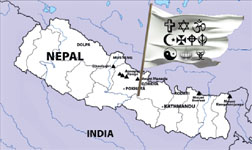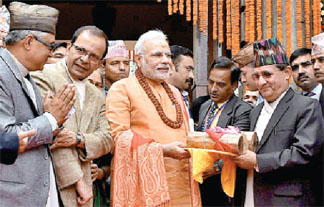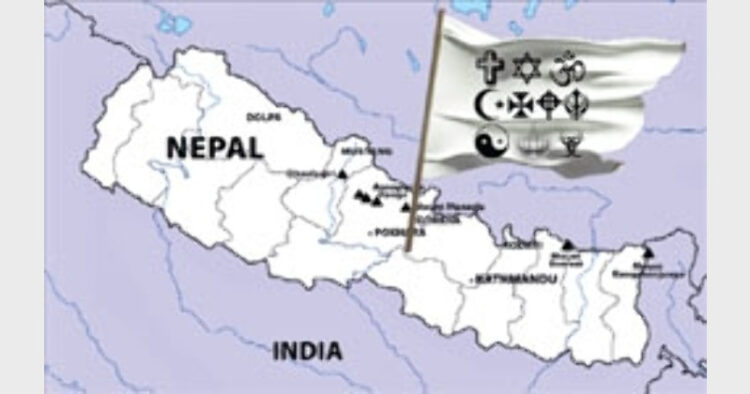 Intro: Now that Nepal is declared as a secular democratic Republic, instead of sticking to the outdated philosophy of theoracratic Brahmanism dominance in the name of Hinduism, it is time for reforms to help build an equitable and just society.?
Intro: Now that Nepal is declared as a secular democratic Republic, instead of sticking to the outdated philosophy of theoracratic Brahmanism dominance in the name of Hinduism, it is time for reforms to help build an equitable and just society.?
The greatest damage done to the cultural nationalism of Nepal was the total negligence of indigenous people and Buddhists by the state with the result, for a long time, even with all the historical proof, we had to shout loud to say that ‘Buddha indeed was born here’. The Nepal Government shied away saying that for 240 years.
The recent visit of Prime Minister Narendra Modi to Nepal and his address in the Constituent Assembly did clarify many myths that politicians in our country made public to believe. His reference to Lumbini, the birth place of Buddha few times in his address and reference to Nepal’s political transformation from ‘Yudh to Budh’ at international level in the UN address has put to rest the blame game that that has been there for long. Where to Nepalese it was told that India wanted to protect the only Hindu kingdom in Asia, Indians are told that indigenous people including Himali Buddhists are anti-Hindu. But this isn’t true.  I believe and want to share with you how some of the greatest thinkers of India defined Hinduism and how we, the Nepali Buddhists, find fault in our country. Swami Vivekananda said, “A true Hindu is a true Buddhist and a true Buddhist is a true Hindu.” Bharatiya Janata Party patriarch L.K. Advani, who is one of the strongest advocates for Hindu nationalism while defining secularism in his book My country My Life wrote ‘Throughout my political life, I have emphasised that Hindutva stands for cultural nationalism, and does not denote religious or theocratic nationalism. The term ’Hindu’ in Hindutva has a cultural, and not a religious connotation. It does not lend itself to a narrow ’for Hindus only’ notion of Indian nationhood, as it stems essentially from underlying cultural ones’. He further said “The concept of ‘cultural nationalism’ enjoins upon the adherent of different faiths to respect, take pride in, not to have extra-territorial loyalty; not to degrade other faiths as false or inferior, but rather to learn from the best that each faith has to offer; not to misuse freedom of religion to expand one’s religious population through fraudulent conversions; and not to try to gain political dominance for the purpose of advocating separatism or establishing theocracy. It means nothing more, nothing less’.
I believe and want to share with you how some of the greatest thinkers of India defined Hinduism and how we, the Nepali Buddhists, find fault in our country. Swami Vivekananda said, “A true Hindu is a true Buddhist and a true Buddhist is a true Hindu.” Bharatiya Janata Party patriarch L.K. Advani, who is one of the strongest advocates for Hindu nationalism while defining secularism in his book My country My Life wrote ‘Throughout my political life, I have emphasised that Hindutva stands for cultural nationalism, and does not denote religious or theocratic nationalism. The term ’Hindu’ in Hindutva has a cultural, and not a religious connotation. It does not lend itself to a narrow ’for Hindus only’ notion of Indian nationhood, as it stems essentially from underlying cultural ones’. He further said “The concept of ‘cultural nationalism’ enjoins upon the adherent of different faiths to respect, take pride in, not to have extra-territorial loyalty; not to degrade other faiths as false or inferior, but rather to learn from the best that each faith has to offer; not to misuse freedom of religion to expand one’s religious population through fraudulent conversions; and not to try to gain political dominance for the purpose of advocating separatism or establishing theocracy. It means nothing more, nothing less’.
For 240 years after the unification of Nepal by Prithivinarayan Shah, Nepal developed its nationalism as Hindu kingdom and people were the subjects of the king. For the first time in 1951 we became the citizens of a country. Nepal’s Hindu kingdom has for long advocated theocratic nationalism which is based on rigid caste system. Its purpose was to subjugate indigenous nationalities under the ruling class of high caste Brahmins in the name of unification.
It is a well established fact that unification can be achieved either by suppressing the difference or by respecting the difference. The state of Nepal opted for the former and the trouble began. I often wonder why the Madeshe Hindus remained suppressed for 240 years under the Hindu kingdom. It is precisely because of this reason that today Madeshes who are Hindus by faith had no option but to revolt against the existing system. They are revolting not against Hindutava but Bahunbad-dominance in the name of religion in every field of their mundane life be it politics education, social life, media etc.
Every nation has a unique identifiable culture of its own that can evoke a sense of cultural nationalism. The greatest saint who walked on this earth 2550 years back, Buddha Sakyamuni was born on our soil at Lumbini and today 19 billion Buddhists around the globe follow his philosophy. Today’s Sakyas and Tharuwats in Nepal claim that they are the decedents of this great saint.
Are we then as Nepalese, ready to say with pride that Buddhism is our cultural nationalism from ancient time? No, we were made to believe that the Sindhoor, topi or daura suruwal is our national symbol to feel proud about.
Buddha’s name can be seen on commercial aero plans, restaurants and public transport services but it remained eluded from the spirit of our cultural ethos. Who then is responsible for all this? Throughout the history and even today there has never been any official appreciation of the contributions made by 5000 odd monasteries dotted from Drachula to Taplejung to Kathmandu Valley in the national fabric of Nepal, at least nationally. Thousands of followers from various countries come to seek truth and peace with their gurus in these monasteries, who until recently were even categorised as illiterate according to the Nepal Government census. In order to tarnish the image of our monasteries, some politicians go to the extent of linking it with Tibetan politics, which is totally condemnable. We follow Tibetan Buddhist as our Gurus and are not limited by geographical boundaries, but it’s not true that we do not follow Tibetan politics.
For the first time when citizens of Nepal especially the suppressed indigenous Madeshi and Himali woke up in an immature democratic exercise 60 years back, we realised that that we are in a state where neither we are proud to say we are Hindus, nor that we are Buddhists.
Today secularism means equal respect to all religions; in anyway, it does not connote anti-religion philosophy. Sixty years in the life of a nation is not a short period especially with a single mission of developing it into a democracy. In Nepal democracy failed and continues to fail even today. It has happened precisely because the exercise was not inclusive, and because Nepal never had a reformer to bring our leaders out of the hallucination of Brahmanic dominance.
Religion and culture should be defined separately. When it comes to maintaining age old tradition like the Kumari anointing the head of the state, as per tradition established 240 years ago, I believe we should follow. It adds dignity to our cultural ethos and does not harm anybody. While at the same time, in the name of tradition, it is sacrilegious to provide state funding to the annual mass sacrifice of goats and buffaloes in the name of retaining Hindu culture. Even the holy cow, who only gets protected under the law, will feel ashamed for all other fellow animals being slaughtered mercilessly in the name of religion. The debate is not whether Hinduism is bad or good. The debate is whether what is followed and advocated in Nepal is Hinduism or not.
Now that Nepal is declared as a secular democratic Republic, instead of sticking to the outdated philosophy of theoracratic Brahmanism dominance in the name of Hinduism, it is time that the Hindu advocates must reform according to time, discuss with the Buddhists/indigenous people and the Madeshes to device a middle way so that all religions are respected equally; encourage historically suppressed faiths so that the poor are not subjected to fraudulent conversions; and put an end to wrong traditions in the name of religion like state supporting the slaughter of millions of animals in Gadimaya festival or scarificing goat at international airport.
We are followers of Nalanda tradition of Buddhism and all our great masters such as Nagarjuna, Arya Deva, Arya Sangha, Shanti Deva and Atish Deepankar etc were all Brahmins and therefore, we are not against Brahmins per say. What we wish to appeal to our Brahmin leaders in Nepal is to have what prime Minister of India said in our parliament “a Rishi maan’-broad minded, inclusive, and far sighted.
The sooner it is understood, the better it is for the people of Nepal. I hope the real Hindusim, as defined by great thinkers of the land of Aryabhumi, a real secularism in keeping with the sentiments of Nepali people, will prevail soon and when that happens, no power in the world can stop Nepal becoming a model for a vibrant democratic secular prosperous country in the world.
Acharya Norbu Sherpa ?(The writer is the General Secretary of the Nepal Buddhist Federation)?













Comments